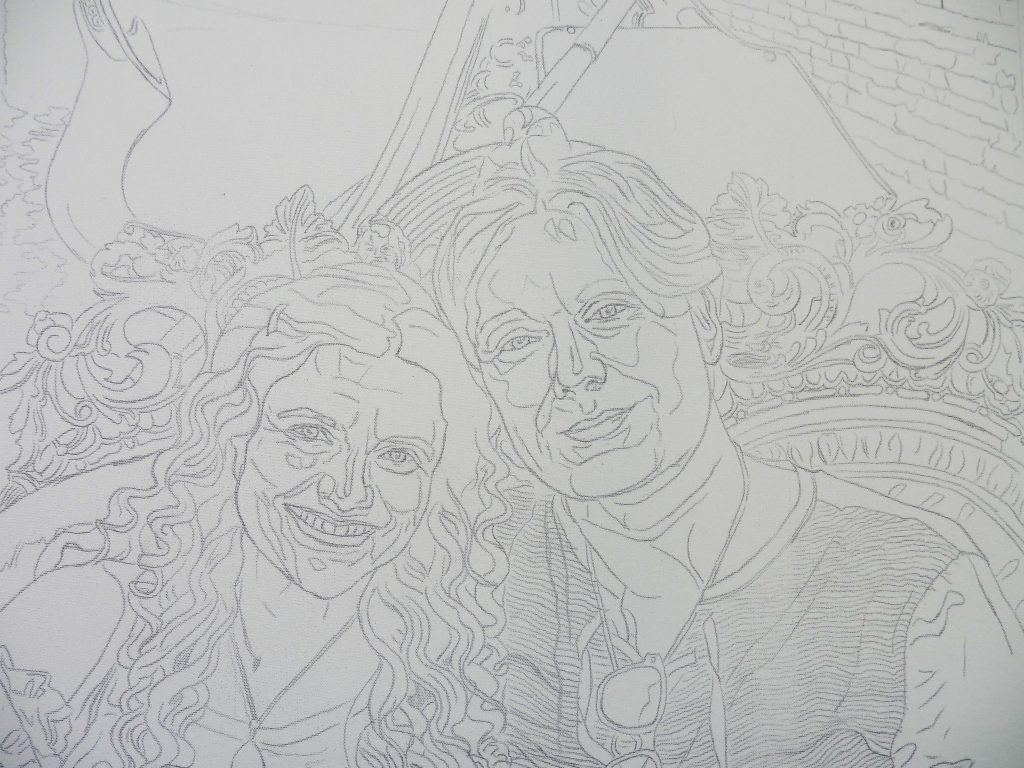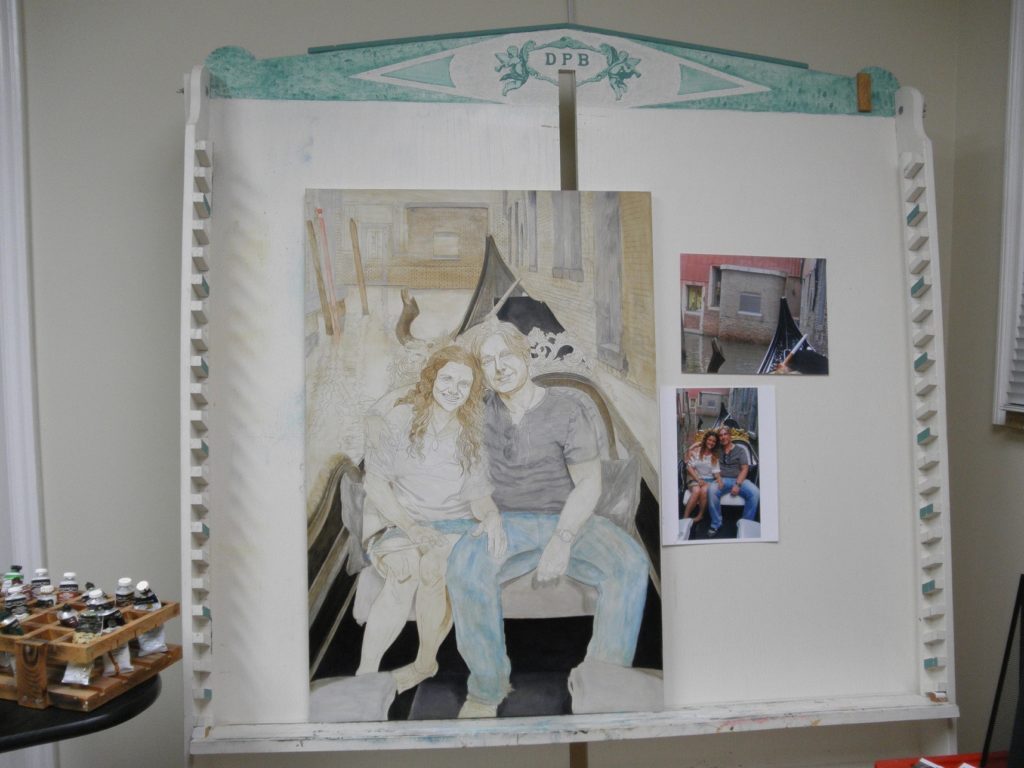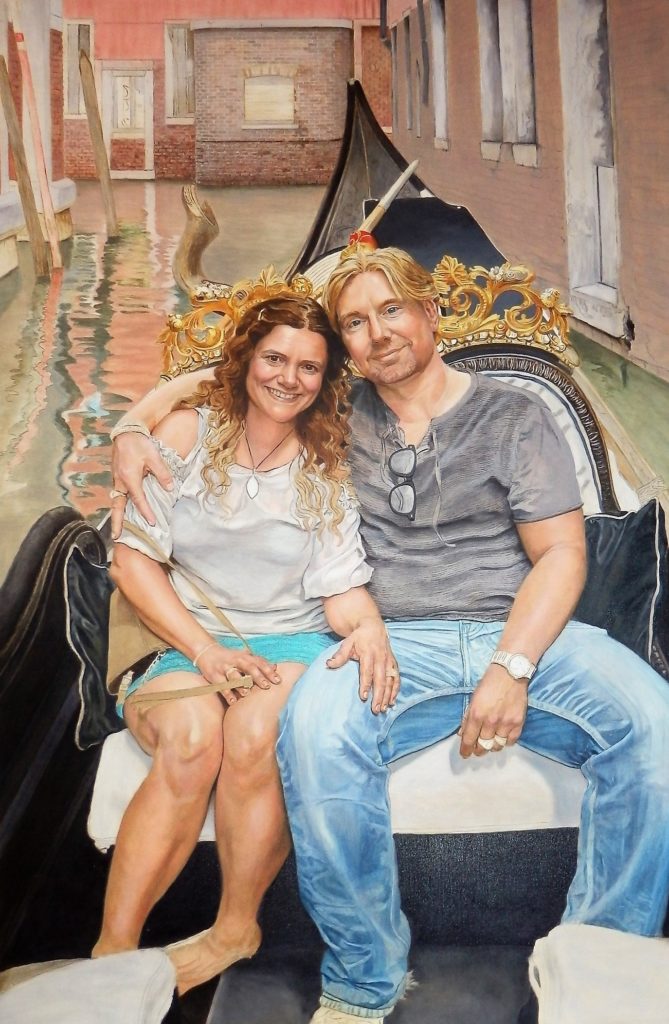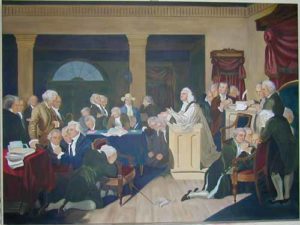“Venice Gondola Ride”
This was a very personal project for me as it is from a snapshot of my daughter and her partner when they visited Venice. Being very fond of the picture (and of Venice!), and in my enthusiasm to put this moment to canvas, I overlooked my cardinal rule, “NEVER WORK FROM AN INFERIOR PICTURE!”
The picture was taken by the Gondolier, with a cell phone, and it was not set for the highest resolution. My mind was determined that this picture needed to find its way to my canvas and I didn’t realize the poor quality until after I had been “committed” to it. So for me, there was no turning back.
Throughout the process of painting this picture, I used over two dozen other snaps taken on the gondola ride, that would help me get an accurate vision of the surrounding area, coloring, lighting, etc.
The unfortunate thing about camera “snaps” is that if great care isn’t taken with angles, etc., it’s easy to get a distortion in the background, thus throwing off the perspective. As the gondolier was focusing on the two people in the boat, and probably very little else, the background and surrounding wall were out of proper perspective. So, my first challenge was to correct this, and it proved to be a rather lengthy and labour intensive exercise!

…Once the drawing was completed, it needed to be transferred to the canvas using graphite paper…

(Completed transfer of drawing onto the canvas.)

(Close up of portion of completed transfer to canvas.)

…After the transfer is complete, the drawing lines are then gone over with acrylic paint to “fix” them…This is important so that if I have to take paint off to correct something later, I will not lose my original drawing…

…A light acrylic wash is then put on to get rid of the stark white canvas, enabling tonal values to be judged more easily…

Color Adjustment
At this point I have to figure out the color scheme of my picture. The coloring of the original photo was too dark and orange toned to be natural.
I did what image adjustments of the photo that I could on the computer, and had 3 different color schemes printed out, but in the end, most of the coloring, especially for skin tones, was taken from other snapshots (selfies) that were taken on the ride.
I used the colors as they appeared directly from the computer screen, which looked more natural, rather than the printed versions, as the printed pictures seemed to mess up the colors. (Perhaps software to sync the computer screen colors to the printer would be a good investment!)

The next step is to start blocking in the colors with oils, starting with the darkest colors and progressing through the lightest…
As this is also “day 1” with oils, and blocking in is part of the oil painting process, I will forego the tedious details and present a gallery depicting the progress of the painting and identify the image in terms of days since starting to use oils.
I would also like to point out that I am using “dream canvas” (which is made from a patented, nylon coated fabric), and I need to always be cognizant of how much paint I am using, as the “tooth” of canvas is very fine .
(Click on image for a slightly larger view)














It took 97 days from the time I picked up my brushes and loaded my palette with oils, to completion. Because I had broken my cardinal rule, it took an additional 4 months to prepare, to get from conception to the transfer of the drawing onto the canvas.
It was a labor of love, and probably one of my most challenging endeavors…Worth it?…Absolutely…Would I do it again?…Not without the proper photo…. The completed “Venice Gondola Ride”

Just an aside…my audio companions for this project were: Joe Bonamassa (An Acoustic Evening at the Vienna Opera House; Live at Carnegie Hall – An Acoustic Evening; and Live from the Royal Albert Hall), Gino Vannelli (Live in LA), and, for occasional variety, the local radio station. And no, I do not get royalties for mentioning them…Ciao.





So here is the process I use… …The Making of a Painting…
5) Next I start adding the deepest values. These would be the darkest aspects of the picture (including clothing, furnishings, etc.)
7) I’ve now started to work on the floor and Shadows on the floor, working my way down to the bottom of the canvas. More color is added to podium, fringe of curtains and more definition to stockings and shoes. Type within this text.

8) In this picture the wall got some attention, I’ve adjusted the color of the far table but most importantly is the painting of the faces. This is very detailed and time consuming for me, and I will spend a lot of time with this area, getting it “just” the way I want “them” to look! There are 36 figures in the picture with 29 needing facial features! I have also spent time here defining Reverend Jacob Duche’s robe

9) I will keep working on faces, adjusting colors and adding highlights until I feel satisfied.The highlights to the curtains and tablecloth are now in which changes the overall look and the shadow of the inner wall has been added. Details to clothing has also been done.I worked on this picture for approximately two months and had many gruelling eight hour days. This is a long time to hold a small paint brush in your hand to do detailed work. But it’s this kind of detailed work that I love. It defines who I am.


